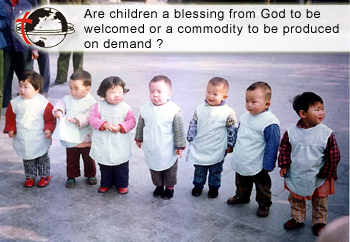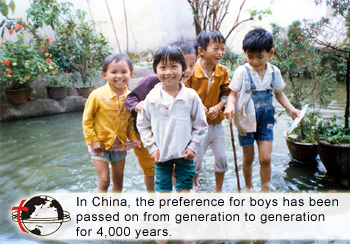
China Bridge (神州橋樑)_2006/Feb
Heavy men, light women and missing girls
This China Bridge feature is part book review and part theological reflection. The book is One Quarter of Humanity: Malthusian Mythology and Chinese Realities, by James Z. Lee and Wang Feng, (Harvard University Press, Cambridge MA, 1999).
Malthus and population growth
Thomas Robert Malthus (1766-1834) of England, published An Essay on the Principles of Population in 1798. He claimed that population growth tends to outpace food production and that unless preventative checks, such as delayed marriage, are used to slow down the birth rate, it would only be a matter of time before positive checks, such as famine, drove the death rate up.
Responsible young adults in western Europe planned ahead, worked hard, saved money and did not marry before they were financially secure, meaning being able to set up an independent nuclear family.
Malthus’ dismal and controversial conclusion, was that charity to the poor only makes matters worse, since they then proceed to have more babies. In later editions of his book, Malthus gathered more material from non-Western countries such as China. Malthus saw China caught in the so-called Malthusian trap of mass poverty at the edge of famine, due to the extended Chinese family enabling and encouraging everyone to marry young.
Chinese demographics


Two centuries later, there is much more material available in English and Chinese about Chinese demographics. Lee and Wang have read most of it. The endnotes and references in this book are half as long as the text. They begin each chapter with a quote from Malthus, then look at the data from China and crunch the numbers to set the record straight.
The average Chinese was not as poorly fed as Malthus had heard and food production in Qing dynasty did somewhat better than rise just fast enough to feed more mouths. The alternative to individuals delaying marriage was not, at least not in China, uncontrolled births but fertility with Chinese characteristics.
Preference for boys
Men outnumbered women. From the time of oracle bone inscriptions 4,000 years ago, the preferred baby was male. Beyond the high infant mortality rate, an extra one- tenth or more of baby girls did not live long. They were either drowned at birth, or underfed and given less medical care.
Those who survived were almost all married by age 20. The one per cent who never married must either have been Buddhist nuns, or severely disabled. Some men either married later, or never had a wife. This pattern is being repeated today, thanks to ultrasound scans and an imbalanced sex ratio at birth.
Social needs determined individual decisions
Fertility was planned, not by the individual but by the extended family. Eldest sons married earlier and averaged more children than did their younger brothers. Married Chinese couples had fewer children than their European counterparts, not 7.5 to nine children per family, but only six, enough for modest population growth despite low life expectancy.
After a woman turned 35, she almost never had additional children. Even today, in Taiwan, people laugh when they hear of an aunt or uncle only a few years older than a nephew or niece. The need for a wide age distinction between generations within the hierarchical family was no joke in the old China, but could prove deadly for the late-born child. Adoption, especially of cousins, was much more common than in the west, to ensure that no couple stayed childless.
In western societies, getting married and starting a family in recent centuries has been a matter between the husband and wife. By contrast, in China, demographic decisions are never individual. They require careful considerations of collective needs at both ends of the social spectrum: the family and the state.
Marriage, for instance, is not a personal arrangement between two individuals. Rather it is an institution through which family and kinship ties are formed, maintained and expanded. Similarly, infanticide is not a result of lack of parental love, but a sacrifice to benefit the whole family.
Rational decision-making in this context is a process of negotiation that takes into full account hierarchical prerogatives and collective interests. What matter are not just individual preferences, but the person’s gender, birth order, relation to the household head within the family, occupation, residence type and political status in the society (p.10).
Same ends, different means
China has now made the transition to low birth and death rates and even rising divorce rates, just as western nations do, but arrived by quite a different route.
Lee and Wang succeed in proving that Malthus was wrong: Chinese were not mindlessly bringing as many babies into the world as possible, without restraint. The locus of decision-making was the wider family, not the couple, yet family planning was practiced for centuries without need for modern medical intervention.
Statistics matter
The authors fail to mention that women had to make most of the sacrifices. Baby girls were often drowned; girls got less food than their brothers and the single life was not an option for the survivors as single men outnumbered them.
If there were 325 million people in China in 1800 and 450 million in 1900, and a fairly high birth rate, then that meant an average of 12 million births a year, or 1.2 billion in the 19th century. Maybe 60 or 70 million of 600 million baby girls were drowned. The authors do not make this calculation.
It may be extremely politically incorrect to do the math. But isn’t 60 million drowned baby girls an indictment of a dysfunctional society? In the dysfunctional and exploitative society of mid-19th century England, John Henry Newman (1801-90) spoke of the “long, sad history of the world,” relating human suffering and sin to the anguish of Jesus in Gethsemane. There is material for theological reflection in both old and new statistics.
Religious and social pressures
Some religions mandate that everyone should get married. Confucianism is listed as a religion in Hong Kong but as a philosophy on the mainland. In any case, Confucius and his disciples have shaped the course of Chinese culture for 2,500 years. The most quoted saying of Mencius (372-289 BC) is “Three things are unfilial; the worst is not to have a son” (不孝有三無後為大). When Buddhist missionaries entered China, one obstacle to the new faith was celibacy for monks and nuns.
If a wife could not bear children, or at least bear a son, then the solution was to take a second wife. Men throughout the world always blame their wives for fertility problems. In practice, rich men got a second woman while poor men went unmarried, or at best married later in life.
What was and still is worse, is overriding the natural sex ratio at birth by eliminating baby girls, either through infanticide, the old fashioned way, or through hi-tech ultrasound scans a few months into the pregnancy.
Every religion condemns infanticide and most faiths at least strongly discourage abortion, but even believers can rationalize their way to making an exception to the rule.
Catholic teaching
Catholic teaching recognises three states in life, married, single and religious. God calls different people differently. In Chapter V of Lumen Gentium, Vatican II made it clear that all the baptised share a universal call to holiness. No one state of life has a monopoly on getting close to God.
In China, at least several percent of today’s boys will reach old age without ever getting married. Once a girl is aborted or dies of neglect, there is no way to bring her back 20 years later as a bride. So the teaching that singles as well as married people have hope of eternal life will be a consolation to at least some bachelors.
Childless men, called bare branches, are unhappy, frustrated and prone to get into all kinds of trouble. Call it “the heart of a heartless world,” or “the opiate of the people,” as Marx did, but the Gospel is good news for the poor.
Even in the 21st century, few are poorer that an under-educated and unmarried laboring man. The “winners” look down on the “losers,” and justify it in terms of Social Darwinism, but if more “losers” become Catholic in the coming years, then China will enjoy more social stability.
Deep-rooted feudal superstition
An old saying to indicate who had weight and influence in society was “heavy men, light women” (重男輕女). Of all the “feudal superstitions” carried into the post-1949 era, this preference for sons is the most deep-rooted and destructive. A mother gains respect by bearing a son, not a daughter. The father also receives more congratulations and both parents feel more secure when facing old age. In some parts of India, there is a saying: “Let my neighbor have daughters.” But when a huge number of couples have this attitude, everyone suffers and the bias is passed to the next generation. In Catholic theology, this is a structural sin.
The damage has already been done. The best that either the government or the Church can do is to cope with the impact to the extent possible. For the future, better education for girls is important.
Even more important is to ask questions: Are children commodities to be produced on demand, to fit the parents, or the state’s quality control standards? Or are they gifts from God to be welcomed, whether planned or unplanned, healthy or unhealthy, male or female?
MJS


 ENG
ENG